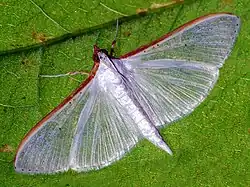Palpita vitrealis
Palpita vitrealis, common name jasmine moth or white pearl, is a species of moth of the family Crambidae.
| Palpita vitrealis | |
|---|---|
 | |
| Moth of Palpita vitrealis | |
| Scientific classification | |
| Kingdom: | |
| Phylum: | |
| Class: | |
| Order: | |
| Family: | |
| Genus: | |
| Species: | P. vitrealis |
| Binomial name | |
| Palpita vitrealis (Rossi, 1794) | |
| Synonyms[1][2][3] | |
|
List
| |
Distribution
This species occurs worldwide, including Africa (Equatorial Guinea, Gambia, Kenya, Sierra Leone, South Africa), [2]Asia, Australia, Europe and America.[4] In Europe, it is mainly found in southern Europe, but may be found further north. [3][5]
Description
.jpg.webp)
The wingspan of Palpita vitrealis can reach 27–31 mm. The body and the wings are translucent with a slight sheen. Eyes are large and reddish-brown. On the upper edge of the forewings is present a rather broad orange or brown border. The forewings also show two black spots in the middle. Legs are white and brown ringed.[6]
Biology
These moths mainly fly from August till late October, depending on the location. They feed on nectar of various flowers, including ivy and buddleia.[6][7] This species shows a migratory nature. The larvae are initially yellow, later becoming green. They can grow to a length of about 2 cms. They feed on the leaves of the host plants, mainly jasmine (Jasminum officinale), privet (Ligustrum species), Forsythia, Arbutus unedo and european olive (Olea europaea). [7] In Africa the preferred host plants are Sida rhombifolia, Grewia, Helicteres isora, Schima noronhae and Randia scortechinii. [2] The larvae are considered a pest of olive fields, as they attack the leaves and fruits. The final instar of the larvae spins some leaves together and form a silky cocoon to pupate.[5]
References
| Wikispecies has information related to Palpita vitrealis. |
| Wikimedia Commons has media related to Palpita vitrealis. |
External links
- Paolo Mazzei, Daniel Morel, Raniero Panfili Moths and Butterflies of Europe and North Africa
- iNaturalist
- Lepinet
- Papillons de Poitou-Charentes
- Lepidoptera Larvae of Australia
